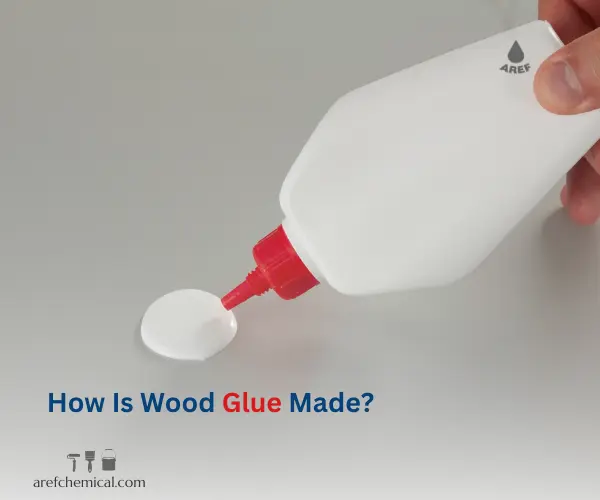Wood glue is one of the most common and widely used types of glue in the woodworking and handicraft industries. Wood glues are known as one of the essential tools in the woodworking, furniture, construction and even handicraft industries. These materials play an important role in connecting wooden parts due to their high adhesive properties and resistance to high environmental factors and their diverse capabilities. This article examines the wood Glue Ingredients and analyzes their different types, properties and applications. Stay with us until the end.
What is wood glue?
Wood glue is a type of specialized adhesive that is mainly used to bond wooden parts. Due to its high adhesiveness and good bonding strength, this adhesive is very popular in the woodworking industry, furniture making, art and decoration, as well as in household tasks.
Wood glue features:
- Strong adhesion: Wood glue usually has high adhesive strength, which provides permanent bonding.
- Moisture resistance: Some types of wood glue have waterproof properties and can be used in humid environments.
- Clear drying: After drying, wood glue usually turns transparent or close to the color of the wood, which contributes to the beauty of the final work.
- Washable: Before drying, wood glue is easily washed off with water.
Wood glue usually comes in liquid form and is easy to use. If you have more questions about the uses or tips for using wood glue, I’m happy to help!
Wood Glue Ingredients
Wood glues are generally composed of chemical compounds and natural or synthetic materials that create a strong bond between wooden surfaces. The choice of adhesive type depends on factors such as the type of wood, environmental conditions (such as humidity and temperature), and the end use. The following is a review of the main ingredients of wood glues.
Wood glue ingredients mainly include natural and synthetic polymers that allow for a strong and stable bond. This glue is usually supplied in liquid form and, after drying, is washable and moisture resistant. In this introduction, we will examine the microscopic structure of wood glue as well as its main properties to better understand the reasons for its popularity and widespread applications.
Natural Materials
In the past, wood glues were often made from natural materials. These materials include the following:
Natural Gums
Gums such as gum arabic or gum from various trees were used as traditional glues. Due to their natural origin, these materials have a high compatibility with the environment, but they are less resistant to moisture and temperature.
Proteins
Animal proteins such as gelatin, casein and dried blood are among the ingredients of old glues. These materials have the ability to form a strong bond with the wood surface due to the presence of active functional groups.
Starch
Natural starches such as corn or potato starch were also used as wood glues. These materials were popular in traditional industries due to their low price and easy availability.
Synthetic Materials
With the advancement of technology, synthetic adhesives have replaced many natural adhesives due to their superior properties and higher strength. These materials include the following:
Formaldehyde resins
Formaldehyde resins are a group of polymers that are produced based on the reaction of formaldehyde with other organic materials such as phenol, urea or melamine. These resins are used as strong adhesives and also for the production of building materials and wood products.
This group includes resins such as urea formaldehyde (UF), phenol formaldehyde (PF) and melamine formaldehyde (MF). Due to their high resistance to moisture and heat, these resins are widely used in the wood industry and the manufacture of wood products such as particleboard and MDF.
Polyurethane resins (PU)
Polyurethane adhesives are used in the furniture and construction industries due to their flexibility and resistance to moisture and chemicals. These adhesives harden and form a strong bond due to their ability to react with ambient moisture. Polyurethane adhesive is a type of adhesive made from polyurethane. This adhesive is used in various industries and for bonding various materials due to its unique properties such as strong adhesion, water resistance, flexibility, heat resistance and quick drying.
Epoxies
Epoxy is a chemical compound known as a type of polymer and is especially used in various industries due to its unique properties. Epoxy usually exists in two main components: an epoxy resin and a hardener, which are combined to create a strong and transparent bond.
Epoxy adhesives are used in connecting heavy wooden pieces and large structures due to their high strength and resistance to environmental factors. These materials consist of two main components (resin and hardener) that create a chemical reaction after mixing.
Polyvinyl acetate (PVA)
Polyvinyl acetate (PVA) is a thermoplastic polymer obtained by the polymerization of vinyl acetate. It is widely used in various industries due to its special properties such as transparency and water resistance.
PVA adhesives are popular in the wood and furniture industries due to their reasonable price and ease of use. These adhesives are less resistant to moisture, but are suitable for indoor applications.
Factors affecting the selection of wood adhesive ingredients
The selection of wood adhesive ingredients depends on several factors:
Environmental conditions: In humid or high-temperature environments, high-strength adhesives such as formaldehyde or polyurethane resins are preferred.
Type of wood: Adhesives used for hardwoods should have higher strength.
End use: In the construction industry, adhesives with high mechanical and chemical resistance are required, while in handicrafts, simpler and cheaper adhesives are sufficient.
Advantages and disadvantages of wood glue ingredients
Wood glue, like any other material in the chemical industry, has advantages and disadvantages.
Advantages
High resistance: Synthetic materials such as formaldehyde resins and polyurethane have high resistance to moisture and heat.
Application type: Different types of glues are available for different applications.
Long-term durability: Many synthetic glues have a longer lifespan.
Disadvantages
Environmental: Some synthetic glues, such as formaldehyde resins, may release toxic substances.
High cost: Advanced glues such as epoxies and polyurethanes are usually expensive.
Sensitivity to environmental conditions: Some glues perform poorly in the presence of moisture or high temperatures.
How is wood glue made?
Wood glue is mainly made from polymeric materials and chemical compounds designed to provide the desired adhesion. The steps in making wood glue can be summarized as follows:
Selection of raw materials
– Polymers: Usually, a mixture of polyvinyl acetate (PVA) is used, which is a type of synthetic polymer and is considered one of the main ingredients of wood glue.
– Additives: Some other materials, such as dyes, antiseptics, and stabilizers, are added to the main composition to improve the properties of the glue.
Production process
– Mixing: The raw materials are carefully combined. This step involves mixing the main polymers with additives and solvents.
– Polymerization: In some cases, the raw materials undergo a polymerization process to form larger molecules that give them greater adhesive properties.
Quality Control
– Testing and Evaluation: After production, the adhesives undergo various tests to ensure quality, stability, and adhesion properties.
Packaging
– The ready-to-use adhesive is released into the market in various packaging, including bottles or cans.
This process helps produce high-quality, high-performance wood adhesive
Conclusion
The wood Glue Ingredients play a key role in determining its properties and applications. From natural materials such as gums and proteins to synthetic materials such as formaldehyde resins and polyurethanes, each has unique properties that make them suitable for specific applications. With advances in technology, modern adhesives not only have higher strength and durability, but also have improved their performance against environmental factors. Choosing the right wood adhesive according to the application and environmental conditions can help improve the quality of wood products and reduce costs.







22 Responses
The ingredients in wood glue significantly impact its bonding strength, drying time, water resistance, and overall suitability for various woodworking applications.
Polyvinyl acetate polymer, water, and sometimes additional additives for improved performance.
Polyurethane Glue Ingredients: Polyurethane prepolymer and water.
Aliphatic Resin Glue (Yellow Glue) Ingredients: Aliphatic resins and solvents.
When selecting wood glue, consider the intended use, environmental conditions, and materials being bonded.
Great
So useful
Some synthetic glues, particularly those containing formaldehyde resins, can release volatile organic compounds (VOCs) and other toxic substances, especially when they are curing or if they are exposed to heat.
When used in adhesives, formaldehyde can off-gas over time, potentially leading to indoor air quality issues.
Exposure to formaldehyde can cause various health issues, including respiratory problems, skin irritation, and has been linked to certain cancers.
Wood glue is an adhesive specifically designed for bonding wood parts together. It’s commonly used in woodworking and carpentry for creating strong, durable joints in furniture, cabinetry, and various wooden structures.
PVA (Polyvinyl Acetate) Most common type, often referred to as white glue or yellow glue. Dries clear and is water-resistant, suitable for indoor use.
Polyurethane Glue: Expands as it cures, creating a very strong bond.
Water-resistant and can bond a variety of materials, including metal and plastic.
Epoxy: Two-part adhesive (resin and hardener).
Provides excellent strength and is also water-resistant.
Hide Glue: Traditional adhesive made from animal collagen.
Used in fine woodworking and for repairs, as it can be reactivated with heat.
Wood glue is typically made from a combination of several key ingredients, which can vary depending on the type and brand.
Water: Acts as the solvent.
PVA Resin: The main binding agent.
Additives: These can include fungicides,
Epoxy
Resin: Typically bisphenol A (BPA) or similar compounds.
Hardener: Often an amine that reacts with the resin to cure it.
Filler: Sometimes added to improve strength or texture.
Polyurethane Glue
Polyurethane Resin: The main binding component.
Moisture: Water in the air helps cure the glue.
Toluene: Sometimes used as a solvent in some formulations.
Always follow the manufacturer’s instructions for best results.
Thanks for the information
Thanks a lot
https://tavatranslation.com/